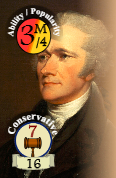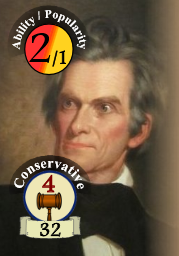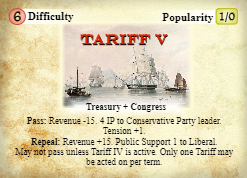
Alexander Hamilton
 Alexander Hamilton |
A Tariff of Abominations
Given that taxation had been a major factor in the Revolutionary War,
it was awkward and ironic that part of the solution
would be new taxes. Congress considered various proposals
and eventually decided to tax carriages, salt, sugar, property
auctions, window panes, tobacco and, disastrously, whisky. A
considerable number of taxes, yet still insufficient.
Thus Congress created a tariff, or tax on imports, which alone
brought in more revenue than all of the other taxes combined.
But the tariff had another benefit as well. In those days the nation
was not the industrial producer it would later become. In fact most of its
exports were in the form of raw materials such as lumber or
agricultural products such as tobacco, textiles and foodstuffs.
But in Great Britain the Industrial Revolution had begun and taken
hold, resulting in large amounts of manufactured product arriving
on American shores and at prices at which fledgling and underfunded
American enterprises found it difficult to complete. The extra tax
on British products tended to level the playing field and thus was
particularly popular in New England, where most such firms were
located at the time. They were less popular in the South, however,
where there was little industry to protect and
which depended on exporting their tobacco, cotton and so on.
Thus the tariff tend to be a divisive issue between North and South,
and later the West (the West being the area closer to the
Mississippi at the time). With the Napoleonic Wars,
the US pursued embargoes and other severe restraints on trade
so in the years 1800-1815 the tariff level receded in importance.
But with the conclusion these wars, the issue returned as never
before. The conclusion of Madison's second term saw passage of the first
protective tariff, i.e. one that went beyond mere revenue goals and
sought to definitively support American industries. It was further
increased under the second Adams administration in 1824. From the
perspective of the South the outlook was bad, especially as the West
had begun siding with the North.
Did it work? Well, the vote was very close, but in the end the
motion passed the House, 105-94. The New England Congressmen smelled
the problems, but decided to hold their noses and vote for it
anyway and President Adams signed it.
As a consequence of their machinations, southerners got a far worse
tariff than they would have otherwise. It reduced the South's income
even more as they were forced to pay high prices to manufacturers.
Exasperated, Vice President Calhoun took a leaf out of the Virginia
and Kentucky Resolutions (secretly authored by Madison and
Jefferson) and wrote The South Carolina Exposition, in which
he propounded the theory that South Carolina could nullify the
"Tariff of Abominations" on the grounds that it violated the
Constitution by treating one part of the country differently than
others. Although the South Carolina legislature printed 5,000 copies
of the pamphlet, it did nothing to actually nullify the law.
More surprisingly new President Andrew Jackson did notthing to
reduce the tariff either. This led to a split between Jackson and
Vice President Calhoun and to further nullification proposals.
By 1832 Jackson reduced tariff rates, but not enough and
Calhoun resigned his office and a special state convention in South
Carolina declared both of the latter tariffs null and void inside
its borders, leading to a Nullification Crisis. The state made
military preparations to resist the federal government. In the Senate
Jackson got help from men like Webster and Frelinghuysen who usually
opposed him to pass a Force Bill that authorized use of the military
against the state.
Eventually cooler heads prevailed. The House Judiciary Committee
rejected the use of force. Calhoun made a major speech opposing it.
The Force Bill stalled. Meanwhile the House went to work on
an acceptable tariff that went back to the 1816 levels. South
Carolina's governor stopped drilling the 25,000 soldiers it had
recruited and postponed the deadline he had set. A commisioner from
Virgina arrived to act as a mediator. Henry Clay came up with a
compromise tariff, got the approval of Calhoun and it passed both
houses, as did the Force Bill. Thus given a choice between compromise and
war, South Carolina repealed its ordinance on March 15, 1833 and
everyone cooled off.
Madison, still alive at the time, wrote prophetically in "Advice to
My Country" that the Union
"should be cherished and perpetuated. Let the open enemy to it be
regarded as a Pandora with her box opened; and the disguised one, as
the Serpent creeping with his deadly wiles into paradise."
Unfortunately it was not published until 1850 and by then dismissed
as a forgery.
While in the end no real harm had been done, as it turned out
this was a dry run for Secession and another step toward Civil War.
In 1860 South Carolina would be the first state to secede.
There is a
long history
of fraud and financial crimes in the United States.
See this article
for information on the charges and penalties for modern day financial crimes.
When Washington took office for the first time, the size of the
government was quite small and expenses were minimal. But Alexander
Hamilton, newly-minted Secretary of the Treasury, wanted to
establish American financial credibility in world markets. His
first step was to get the federal goverment to assume the debts
the states had incurred during the Revolutionary War – $25 million –
(the "Assume State Debts" issue in the game) as well as honor the
loans incurred by the Articles of Confederation – $52 million –
(the "Pay Off War Bonds" issue). Suddenly there was a great need for
money. Where to find it?
What could the South do? In 1828 hat tiger of the the Southern cause, John
C. Calhoun, and his allies cooked up a scheme. They concoted an
insane tariff plan. Not only did it continue to tax all the
manufactureds, it would also tax the raw materials needed by New England
industries. How would this help them? Their idea, Calhoun admitted
nine years later, was that surely New England would reject the plan
out of hand and then the southerners could for once make northerners
look like naysayers, laying the blame for killing the tariff at their feet.
As a consequence, they hoped, no tariff bill would be passed at all
and the southerners would appear as if they had tried to cooperate.

John C. Calhoun

The Tariff of Abominations
Created: 27 October 2015